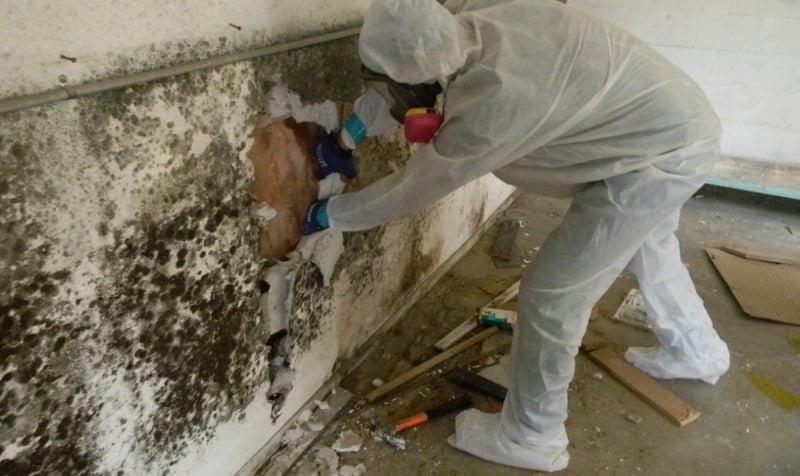IS YOUR HOUSE MAKING YOU SICK?
Your house could have mold! Mold and fungi have existed longer than humans on this planet and are ubiquitous in the outdoors. The problem of mold in the environment is not a new one, but it has become increasingly prevalent since buildings were sealed after the ’70s energy crunch.
Mold can become trapped in buildings and, when moisture is present, create heavy concentrations of mold whose effects on humans range from mildly allergenic to highly toxic.
 ASK YOURSELF THESE QUESTIONS
ASK YOURSELF THESE QUESTIONS
Has there been water damage?
Do you feel better outside your home than inside?
Is there a stale or musty odor?
HAVE YOU EXPERIENCED ANY OF THESE SYMPTOMS?
Headaches
Skin Irritations
Sore Eyes
Coughing
Wheezing
Nausea
Sore Throat
Sneezing
Nose Bleeds
Memory Loss
Dizziness
Respiratory Infections
WHAT IS MOLD?
 Mold is fungi. There are thousands of species. Their microscopic particles are everywhere – in indoor air as well as outdoor air. Mold is extremely common in homes and buildings and will grow anywhere there is moisture.
Mold is fungi. There are thousands of species. Their microscopic particles are everywhere – in indoor air as well as outdoor air. Mold is extremely common in homes and buildings and will grow anywhere there is moisture.
When damp, warm, or humid conditions are present, mold is able to grow on such diverse materials as wood, insulation, drywall, carpet, cloth, and most porous materials. Mold typically reproduces through spores that are released into the air and land where they thrive on moist organic materials. These spores then germinate and explode into colonies. The factors that determine the rate of growth include moisture, type of food or organic material, temperature, and many others.
People often come in contact with mold in moist areas in or around their homes or when mold spores become airborne. The airborne mold spores can come into contact with people either through the skin or when inhaled.
Mold becomes “toxic” when it is in large concentrations. If the mold spores are “toxic”, they can adversely affect your health. The effect on your body will depend on the type of mold involved, the metabolic byproduct of the mold, how much contact there is and the length of exposure, as well as the susceptibility of the individual.
WHERE DOES MOLD GROW?
Mold will grow anywhere, especially where water damage may have occurred, such as leaking roofs, pipes, walls, plant pots, or where there has been flooding. Many building materials provide suitable nutrients that encourage mold to grow. Wet cellulose materials, including paper and paper products, cardboard, ceiling tiles, wood, and wood products, are particularly conducive to the growth of some mold. Other materials such as dust, paints, wallpaper, insulation materials, drywall, carpet, fabric, and upholstery commonly support mold growth.
WHY REMOVE MOLD?
Houses, like people, can become “sick” and infected. Mold is everywhere and has been for centuries. It is only when concentrations become excessive that people are affected. Some people are more susceptible to mold than others, but toxic mold can be particularly dangerous to infants, children, the elderly, and immune-compromised individuals. These illnesses can be significantly lessened and even eliminated by cleaning the environment that produces mold.
WHAT NOT TO DO IF YOU HAVE A MOLD PROBLEM:
DON’T HIRE GENERAL CONTRACTORS OR CARPET CLEANERS WHO CLAIM TO REMOVE MOLD.
Many contractors, carpet cleaners, and other trade people have jumped on the mold bandwagon and claim they remove mold as an additional service. They may cause mold spores to become airborne and spread throughout the area, more often than not making the problem worse. Only work with people who have been properly trained are certified in mold remediation, and who specializes in the process.
DON’T SPRAY BLEACH AND WATER ON YOUR VISIBLE MOLD.
Unless your mold problem is limited to the bathtub or shower tiles and is in a very small, enclosed area, you could cause more harm than good. The instant mold is hit with bleach, it becomes airborne and can land elsewhere and begin to grow. You may be successful in killing a small portion of it, but you could also be successful in cross-contaminating the area. In order to kill mold with bleach and water solution, the problem area must soak in the solution for approximately 7-10 minutes.
DON’T IGNORE MOLD
Mold will not go away on its own! The problem must be remediated by a certified professional or it may get much worse. Because mold is a living organism, the longer you ignore it, the more it may grow and the worse your problem may become. You may risk further illness, additional structural damage, and expensive lawsuits if you have tenants who are exposed to mold.
JUST GIVE US A CALL
We will provide you with a proposal tailored to your budget, time constraints, and your specific needs. If you have any questions, please feel free to contact us through our web page or call us at (808) 494-0365 and ask our staff any questions you may have regarding mold in your building.
